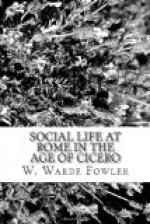It would probably be unjust to the Roman of the late Republic to assume that this beautiful idea of the common life of the human and divine beings in a house was entirely ignored or forgotten by him. No doubt the reality of the belief had vanished; it could not be said of the city family, as Ovid, said of the farm-folk:[377]
ante focos olim scamnis considere longis
mos erat et mensae credere adesse deos.
The great noble or banker of Cicero’s day could no longer honestly say that he believed in the real presence of his family deities; the kernel of the old feeling had shrunk away under the influence of Greek philosophy and of new interests in life, new objects and ambitions. But the shell remained, and in some families, or in moments of anxiety and emotion, even the old feeling of religio may have returned. Cicero is appealing to a common sentiment, in a passage already once quoted (de Domo, 109), when he insists on the real religious character of a house: “his arae sunt, his foci, his di penates: his sacra, religiones, caerimoniae continentur.” And this was in the heart of the city; in the country-house there was doubtless more leisure and opportunity for such feeling. In the second century B.C. old Cato had described the paterfamilias, on his arrival at his farm from the city, saluting the Lar familiaris before he goes about his round of inspection; and even Horace hardly shows a trace of the agnostic when he pictures the slaves of the farm, and the master with them, sitting at their meal in front of the image of the Lar[378]. We may perhaps guess that with the renewal of the love of country life, and with that revival of the cultivation of the vine and olive, and indeed of husbandry in general, which is recognisable as a feature of the last years of the Republic, and which is known to us from Varro’s work on farming, and from Virgil’s Georgics, the old religion of the household gained a new life.
It is not necessary here to give any detailed account of the shape and divisions of a Roman house of the city; full and excellent descriptions may be found in Middleton’s article “Domus” in the Dictionary of Antiquities, and in Lanciani’s Ruins and Excavations of Ancient Rome; and to these should be added Mau’s work on Pompeii, where the houses were of a Roman rather than a Greek type. What we are concerned with is the house as a home or a centre of life, and it is only in this aspect of it that we shall discuss it here.
The oldest Italian dwelling was a mere wigwam with a hearth in the middle of the floor, and a hole at the top to let the smoke out. But the house of historical times was rectangular, with one central room or hall, in which was concentrated the whole indoor life of the family, the whole meaning and purpose of the dwelling. Here the human and divine inhabitants originally lived together. Here was the hearth, “the natural altar of the dwelling-room of man,”




